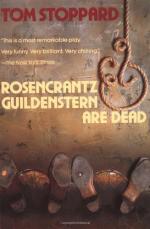|
This section contains 267 words (approx. 1 page at 400 words per page) |

|
Rosencrantz and Guildenstern Are Dead Summary & Study Guide Description
Rosencrantz and Guildenstern Are Dead Summary & Study Guide includes comprehensive information and analysis to help you understand the book. This study guide contains the following sections:
This detailed literature summary also contains Further Study and a Free Quiz on Rosencrantz and Guildenstern Are Dead by Tom Stoppard.
Rosencrantz and Guildenstern Are Dead, Tom Stoppard's best-known and first major play, appeared initially as an amateur production in Edinburgh, Scotland, in August of 1966. Subsequent professional productions in London and New York in 1967 made Stoppard an international sensation and three decades and a number of major plays later Stoppard is now considered one of the most important playwrights in the latter half of the twentieth century.
Recognized still today as a consistently clever and daring comic playwright, Stoppard startled and captivated audiences for Rosencrantz and Guildenstern Are Dead when he retold the story of Shakespeare's Hamlet as an absurdist-like farce, focusing on the point of view of two of the famous play's most insignificant characters. In Shakespeare's play, Rosencrantz and Guildenstern are little more than plot devices, school chums summoned by King Claudius to probe Hamlet's bizarre behavior at court and then ordered to escort Hamlet to England (and his execution) after Hamlet mistakenly kills Polonius. Hamlet escapes Claudius's plot and engineers instead the executions of Rosencrantz and Guildenstern, whose deaths are reported incidentally after Hamlet returns to Denmark. In Stoppard's play, Rosencrantz and Guildenstern become the major characters while the Hamlet figures become plot devices, and Stoppard's wildly comic play becomes the story of two ordinary men caught up in events they could neither understand nor control. Stoppard's play immediately invited comparisons with Samuel Beckett's Waiting for Godot and also brought to mind George Bernard Shaw, Oscar Wilde, and Luigi Pirandello. "Stoppardian" is now a recognizable epithet that suggests extraordinary verbal wit and the comic treatment of philosophical issues in often bizarre theatrical contexts.
Read more from the Study Guide
|
This section contains 267 words (approx. 1 page at 400 words per page) |

|



